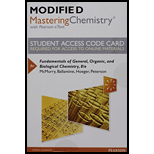
Concept explainers
Interpretation:
Either polynucleotide synthesized from 3’ to 5’end or 5’ to 3’ end has to be interpreted.
Concept Introduction:
Composition of
Sugar: In both DNA and RNA, sugar portion is found. In DNA, the sugar is D-ribose, where at 2’hydroxyl group is absent and in RNA, the hydroxyl group is present at 2’.
Nitrogenous bases: Five types of nitrogenous bases (has unique one-letter code A, G, T, U, and C) are derived from two parent compounds called purine and pyrimidine. The purine derivatives are Adenine and Guanine, which are two fused nitrogen containing rings. The pyrimidine derivatives are Thymine, Cytosine and Uracil, which are nitrogen containing six-membered ring. Adenine, Guanine, Thymine, and Cytosine are the nitrogenous bases present in DNA. Adenine, Guanine, Cytosine and Uracil are the nitrogenous bases present in RNA.
Numbering the atoms in sugar and base rings:

In order to distinguish the atoms in the sugar of a nucleoside and atoms of a base ring, numbers without prime is used for atoms in the base ring and numbers with prime used for the atoms in the sugar ring.
Want to see the full answer?
Check out a sample textbook solution
Chapter 26 Solutions
Modified Mastering Chemistry With Pearson Etext -- Standalone Access Card -- For Fundamentals Of General, Organic, And Biological Chemistry (8th Edition)
- List the pyrimidine bases, the purine bases, and the base-pairing rules for DNA.arrow_forwardHow many by-product water molecules are produced during the formation of the trinucleotide from three mononucleotides?arrow_forwardWhat is the difference between the 3′ end and the 5′ end of a polynucleotide?arrow_forward
- How does a dideoxynucleotide differ from a deoxynucleotide?arrow_forwardHow many combinations of DNA bases are for a polynucleotide of 7 base pairs in length?arrow_forwardWhat are the monomers that makeup a nucleic acid and what are the monomers composed of? What type of bond is found along the backbone of the DNA backbone?arrow_forward
- If a polyribonucleotide contains equal amounts ofrandomly positioned adenine and uracil bases, what proportion of its triplets will encode (a) phenylalanine, (b)isoleucine, (c) leucine, (d) tyrosine?arrow_forwardHow many different 8-mer sequences of DNA are there?arrow_forwardWhy is the α-helix so prevalent?arrow_forward
- Based on Chargaff’s rules, if a segment of DNA is composed of 20% adenine (A) bases, what is the percentage of guanine (G)?arrow_forwardWhat would the effect be if there was a substitution of one nucleotide for another?arrow_forwardAre there other possible conformations of the double helix?arrow_forward
 Human Biology (MindTap Course List)BiologyISBN:9781305112100Author:Cecie Starr, Beverly McMillanPublisher:Cengage Learning
Human Biology (MindTap Course List)BiologyISBN:9781305112100Author:Cecie Starr, Beverly McMillanPublisher:Cengage Learning Human Heredity: Principles and Issues (MindTap Co...BiologyISBN:9781305251052Author:Michael CummingsPublisher:Cengage Learning
Human Heredity: Principles and Issues (MindTap Co...BiologyISBN:9781305251052Author:Michael CummingsPublisher:Cengage Learning

